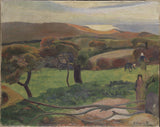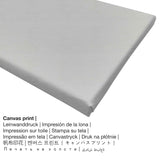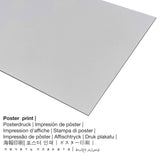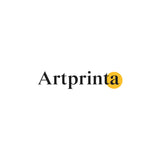Paul Gauguin, 1889 - French: Les Champs beside the merLandscape from Britain - fine art print
Taxes incluses. Frais de port calculés au paiement.
Original artwork specifications by Nationalmuseum Stockholm (© - by Nationalmuseum Stockholm - www.nationalmuseum.se)
English: In the 1880s, Paul Gauguin occasionally went to Bretagne, where he was taken by the landscape and local traditions. This painting shows an actual part of the coast, in a subjective interpretation where the decorative effects of colour fields and contours are the key element. The orange sections have shadows in a contrasting blue. This new style was called Synthetism. In autumn 1892, the artist Richard Bergh bought Landscape from Bretagne from Gauguin’s wife. This painting inspired many Swedish artists. "Landskap från Bretagne" målades sannolikt under sommaren 1889. Gauguin vistades då för andra gången i Bretagne, dit han sökt sig för kunna leva billigt och för att få ro att arbeta. Han arbetade tillsammans med målaren Émile Bernard. Under inflytande från Bernards måleri och idéer om en dekorativt orienterad konst utvecklade Gauguin sitt typiska formspråk där markerade konturer och hela färgfält i samma färgton är framträdande drag. Stilen kom att kallas syntetism - det handlade om att göra en syntes, en slags sammanfattning av motivet. Gauguin var fascinerad av landskapet och livet i Bretagne. Han uppskattade de traditionella dräkterna och befolkningens djupa religiositet. För Gauguin framstod människorna i Bretagne som enkla och opåverkade av den moderna civilisationen. Till vännen Vincent van Gogh skrev han att bönderna i Bretagne gav intryck av att fortfarande leva på medeltiden. "Landskap från Bretagne" föreställer ett kustlandskap sent på dagen. Den lågt stående solen reflekteras i havet i bakgrunden. Målningen är uppbyggd av böljande bågformer och linjer - i trädens stammar och kronor, i de liggande stammarna i förgrunden, i strandlinjen och i molnslöjorna på himlen. Gauguin har över stora områden på duken arbetat med korta vertikala penseldrag som betonar att bildens ytmässighet. Han har med andra ord inte strävat efter att skapa en illusion av djup i bilden. Målningen föreställer sannolikt höjderna väster om Le Pouldu, men är säkert utförd i ateljé och inte på plats inför motivet. Till skillnad från impressionisterna hävdade syntetisterna att ett motiv skulle bearbetas och filtreras av minnet innan det utfördes i en målning. Få enskilda konstverk har tillmätts en större betydelse för den svenska konsthistorien än Gauguins "Landskap från Bretagne". Orsaken är att målningen tillhörde målaren Richard Bergh, som köpt den i Köpenhamn av Gauguins danska hustru Mette på hösten 1892. Bergh var en central gestalt i svenskt konstliv under åren kring sekelskiftet 1900, och många konstnärer hade möjlighet att se Gauguins landskap i Berghs hem. Gauguins måleri i allmänhet och "Landskap från Bretagne" i synnerhet har uppfattats som avgörande impulsgivare för det svenska 1890-talets dekorativt orienterade nationella landskapsmåleri och särskilt för Karl Nordströms konst. Då Richard Bergh undervisade vid Konstnärsförbundets skola lät han dessutom målningen hänga i lokalerna för att vara tillgänglig för studium. I och med att Richard Bergh 1915 tillträdde som överintendent för Nationalmuseum deponerade han målningen i museet. Efter Berghs död beslutade Nationalmusei Vänner att målningen skulle inlösas av museet för 10 000 kronor. En medlem av föreningen, direktör Hjalmar Granhult, agerade emellertid på egen hand och täckte kostnaden samt överlämnade målningen som gåva till museet den 20 juni 1919.
Structured artwork data
| Title of the artpiece: | "French: Les Champs beside the merLandscape from Britain" |
| Classification of the work of art: | painting |
| General term: | modern art |
| Temporal classification: | 19th century |
| Created in the year: | 1889 |
| Artwork age: | 130 years old |
| Artwork original medium: | oil on canvas |
| Original dimensions (artwork): | Height: 72,5 cm (28,5 ″); Width: 91 cm (35,8 ″) Framed: Height: 97 cm (38,1 ″); Width: 117 cm (46 ″); Depth: 11 cm (4,3 ″) |
| Museum / location: | Nationalmuseum Stockholm |
| Museum location: | Stockholm, Stockholm County, Sweden |
| Available at: | Nationalmuseum Stockholm |
| License of artwork: | public domain |
| Courtesy of: | Nationalmuseum Stockholm & Wikimedia Commons |
Structured artist information
| Name of the artist: | Paul Gauguin |
| Alias names: | Gauguin Paul, Paul Gauguin, gauguin p., Gauguin Eugène-Henri-Paul, Gauguin Eugène Henri Paul, Paul Gaugin, Gauguin, gauguin paul, P. gaugin, גוגן פול, Gogen Polʹ, Gauguin Pablo, Eugene-Henri Gauguin, p. gauguin, Gaugin Paul, Kao-keng |
| Artist gender: | male |
| Nationality of artist: | French |
| Jobs of the artist: | painter, graphic artist, sculptor |
| Country of origin: | France |
| Classification of the artist: | modern artist |
| Styles of the artist: | Impressionism |
| Lifetime: | 55 years |
| Year born: | 1848 |
| City of birth: | Paris, Ile-de-France, France |
| Year of death: | 1903 |
| Place of death: | Atuona, French Polynesia |
Structured item details
| Product classification: | wall art |
| Method of reproduction: | reproduction in digital format |
| Production technique: | UV print / digital printing |
| Origin of the product: | Germany |
| Type of stock: | on demand |
| Intended usage: | wall décor, wall art |
| Artwork orientation: | landscape alignment |
| Aspect ratio: | 1.2 : 1 length to width |
| Interpretation of image aspect ratio: | the length is 20% longer than the width |
| Item material variants: | metal print (aluminium dibond), acrylic glass print (with real glass coating), poster print (canvas paper), canvas print |
| Canvas print (canvas on stretcher frame) sizes: | 60x50cm - 24x20", 120x100cm - 47x39", 180x150cm - 71x59" |
| Acrylic glass print (with real glass coating): | 60x50cm - 24x20", 120x100cm - 47x39", 180x150cm - 71x59" |
| Poster print (canvas paper) sizes: | 60x50cm - 24x20", 120x100cm - 47x39" |
| Aluminium print: | 60x50cm - 24x20", 120x100cm - 47x39" |
| Framing of the art copy: | no frame |
Choose your product material option
We offer a range of various sizes and materials for every product. You can choose your your favorite size and material among the following options:
- Canvas print: The printed canvas applied on a wood frame. Also, a printed canvas creates a cosy and comfortable atmosphere. Your canvas print of this artpiece will give you the unique chance to transform your custom fine art print into a large artpiece. Canvas prints are relatively low in weight. This means, it is easy and straightforward to hang your Canvas print without extra wall-mounts. Canvas prints are suited for all kinds of walls.
- Poster print (canvas material): The poster is a UV printed canvas paper with a slight surface finish. Please note, that depending on the size of the poster we add a white margin of something between 2-6cm around the work of art, which facilitates the framing.
- Print on acrylic glass: An acrylic glass print, which is sometimes named as a plexiglass print, will transform your favorite original artwork into décor and forms a distinct alternative option to aluminium or canvas art prints. The major benefit of a plexiglass fine art copy is that contrasts and small color details will be visible due to the granular gradation of the print. Our acrylic glass protects your chosen art replica against light and heat for many years.
- Aluminium print (aluminium dibond): This is a metal print made on aluminium dibond material with an outstanding depth - for a modern impression and non-reflective surface. The Direct Print on Aluminum Dibond is the ideal introduction to fine art reproductions with aluminum. The UV print on aluminium is one of the most demanded entry-level products and is an extremely sophisticated way to display art reproductions, as it draws focus on the image.
In 1889 the male painter Paul Gauguin painted the masterpiece. The original was made with the size: Height: 72,5 cm (28,5 ″); Width: 91 cm (35,8 ″) Framed: Height: 97 cm (38,1 ″); Width: 117 cm (46 ″); Depth: 11 cm (4,3 ″) and was painted with the medium oil on canvas. What is more, the artpiece is in the the Nationalmuseum Stockholm's art collection, which is Sweden's museum of art and design, a Swedish government authority with a mandatet o preserve cultural heritage and promote art, interest in art and knowledge of art. With courtesy of: Nationalmuseum Stockholm & Wikimedia Commons (licensed: public domain).The creditline of the artwork is the following: . The alignment of the digital reproduction is landscape and has a side ratio of 1.2 : 1, which implies that the length is 20% longer than the width. Paul Gauguin was a male painter, sculptor, graphic artist, whose art style can be classified as Impressionism. The Impressionist painter was born in the year 1848 in Paris, Ile-de-France, France and passed away at the age of 55 in the year 1903.
Legal disclaimer: We try whatever we can in order to describe our products as precisely as possible and to demonstrate them visually. Please keep in mind that the pigments of the printing material, as well as the imprint can vary marginally from the presentation on your device's monitor. Depending on your screen settings and the condition of the surface, not all color pigments are printed as realistically as the digital version on this website. In view of the fact that all our fine art prints are processed and printed by hand, there may also be minor discrepancies in the exact position and the size of the motif.
© Copyrighted by - www.artprinta.com (Artprinta)














